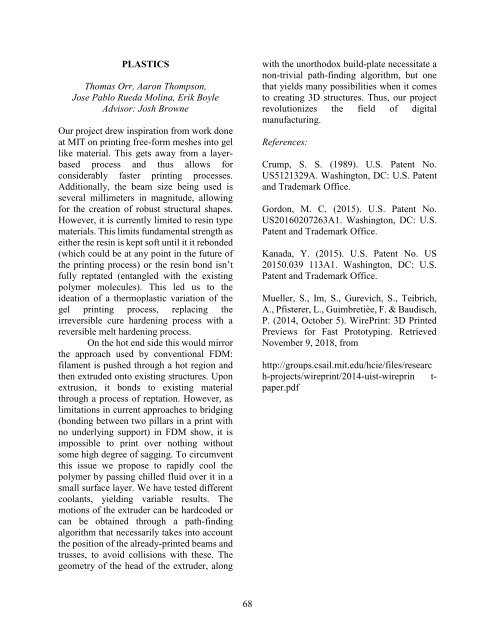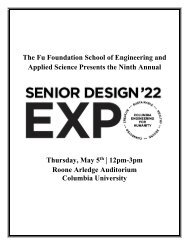Senior Design Expo 2019
The Senior Design Expo, held annually in May at Columbia University, is an opportunity for Columbia Engineering students to showcase what they have learned in their foundational math and science courses together with their engineering courses in innovative, creative, and purposeful designs and prototypes. Each year the Expo showcases more than 60 projects across all nine departments. Projects have included cutting-edge robotics, the New York City subway system, language technology, proposals for bridges to span the Hudson river, and much more.
The Senior Design Expo, held annually in May at Columbia University, is an opportunity for Columbia Engineering students to showcase what they have learned in their foundational math and science courses together with their engineering courses in innovative, creative, and purposeful designs and prototypes. Each year the Expo showcases more than 60 projects across all nine departments. Projects have included cutting-edge robotics, the New York City subway system, language technology, proposals for bridges to span the Hudson river, and much more.
Create successful ePaper yourself
Turn your PDF publications into a flip-book with our unique Google optimized e-Paper software.
PLASTICS<br />
Thomas Orr, Aaron Thompson,<br />
Jose Pablo Rueda Molina, Erik Boyle<br />
Advisor: Josh Browne<br />
Our project drew inspiration from work done<br />
at MIT on printing free-form meshes into gel<br />
like material. This gets away from a layerbased<br />
process and thus allows for<br />
considerably faster printing processes.<br />
Additionally, the beam size being used is<br />
several millimeters in magnitude, allowing<br />
for the creation of robust structural shapes.<br />
However, it is currently limited to resin type<br />
materials. This limits fundamental strength as<br />
either the resin is kept soft until it it rebonded<br />
(which could be at any point in the future of<br />
the printing process) or the resin bond isn’t<br />
fully reptated (entangled with the existing<br />
polymer molecules). This led us to the<br />
ideation of a thermoplastic variation of the<br />
gel printing process, replacing the<br />
irreversible cure hardening process with a<br />
reversible melt hardening process.<br />
On the hot end side this would mirror<br />
the approach used by conventional FDM:<br />
filament is pushed through a hot region and<br />
then extruded onto existing structures. Upon<br />
extrusion, it bonds to existing material<br />
through a process of reptation. However, as<br />
limitations in current approaches to bridging<br />
(bonding between two pillars in a print with<br />
no underlying support) in FDM show, it is<br />
impossible to print over nothing without<br />
some high degree of sagging. To circumvent<br />
this issue we propose to rapidly cool the<br />
polymer by passing chilled fluid over it in a<br />
small surface layer. We have tested different<br />
coolants, yielding variable results. The<br />
motions of the extruder can be hardcoded or<br />
can be obtained through a path-finding<br />
algorithm that necessarily takes into account<br />
the position of the already-printed beams and<br />
trusses, to avoid collisions with these. The<br />
geometry of the head of the extruder, along<br />
with the unorthodox build-plate necessitate a<br />
non-trivial path-finding algorithm, but one<br />
that yields many possibilities when it comes<br />
to creating 3D structures. Thus, our project<br />
revolutionizes the field of digital<br />
manufacturing.<br />
References:<br />
Crump, S. S. (1989). U.S. Patent No.<br />
US5121329A. Washington, DC: U.S. Patent<br />
and Trademark Office.<br />
Gordon, M. C. (2015). U.S. Patent No.<br />
US20160207263A1. Washington, DC: U.S.<br />
Patent and Trademark Office.<br />
Kanada, Y. (2015). U.S. Patent No. US<br />
20150.039 113A1. Washington, DC: U.S.<br />
Patent and Trademark Office.<br />
Mueller, S., Im, S., Gurevich, S., Teibrich,<br />
A., Pfisterer, L., Guimbretièe, F. & Baudisch,<br />
P. (2014, October 5). WirePrint: 3D Printed<br />
Previews for Fast Prototyping. Retrieved<br />
November 9, 2018, from<br />
http://groups.csail.mit.edu/hcie/files/researc<br />
h-projects/wireprint/2014-uist-wireprin t-<br />
paper.pdf<br />
68








